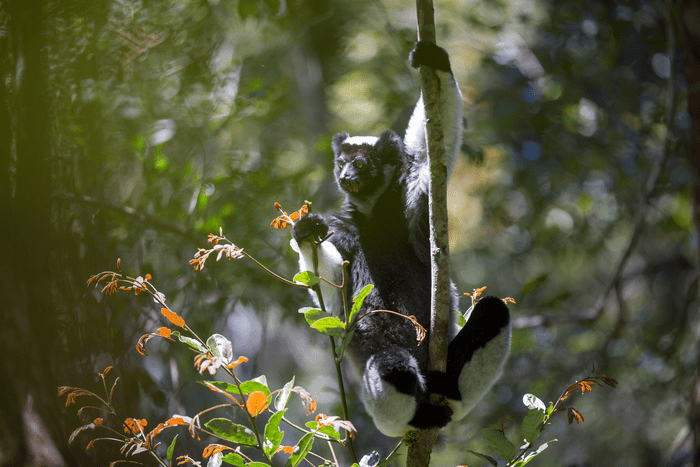
A cute, long-limbed lemur native to the rainforest of Madagascar is recognized as one of the few ‘singing’ primates in the world. Their lovely songs or terrible roars — depending on whom you ask — play important roles in the myths and legends of the Malagasy people. But their status may be even grander.
According to a new study, the Indri indri lemurs are not only capable of hitting notes, their songs also exhibit rhythm. This would make them part of a select musical club in the animal kingdom, mostly composed, until now, of songbirds and humans.
This primate’s got rhythm — all the more reason to cherish it
Many great composers have often described music as ‘having a conversation’. Indeed, what we commonly refer to as bird and whale “songs” are actually communication systems, which leads us to language. Humans are the only primates capable of both acquired vocalization (speech) and musicality, which begs the question of how these traits evolved and how interconnected they are.
Biologists have often turned to our closest living primate relatives for clues. The natural communication of apes may hold clues about language origins, especially because apes frequently gesture with limbs and hands, a mode of communication thought to have been the starting point of human language evolution.
However, musicality is much more mysterious. Let’s just say other apes aren’t that interested in tunes, which is all the more intriguing since music seems to have been an integral part of the human experience since prehistoric times. The oldest musical instrument is a flute carved from cave bear bones by Neanderthals some 50,000 years ago.
This is why the indri, a black-and-white primate about the size of a dog, is so fascinating. In 2016, researchers found that indris co-sing certain parts of their song with other group members, effectively forming a choir.
Now, researchers at the University of Turin and the Max Planck Institute for Psycholinguistics have gone a step further, showing the primates possess categorical rhythm. This type of rhythm refers to intervals between sounds that have exactly the same duration (1:1 rhythm) or doubled duration (1:2 rhythm). Even when sung at different tempos, the categorical rhythm is what allows songs to be easily recognizable.
“Despite its preponderance in our lives, the existence of music is biologically puzzling, as the selective advantage of musicality in humans is highly debated. We know that human musical behaviors exhibit a few ‘rhythmic universals’, and the presence of categorical rhythms is one of them. Since indris’ songs are composed of notes that are organized in phrases, we wanted to understand if they would share the same categorical rhythms that are typical of human music. We indeed found that indris’ songs possess the same categorical rhythms that can be found in the intro of “we will rock you”, by the famous band Queen!” first author Chiara de Gregorio told ZME Science.

These findings are the result of twelve years worth of painstaking fieldwork in the rainforest of Madagascar. During this time, the researchers recorded songs from twenty indri groups, comprising 39 individuals, in their natural habitat.
“Indris live all their life up in the canopy of Madagascar’s rainforest, jumping from tree to tree up and down the hills. So, for many years, we have followed them in the humid forest in every weather condition! Some days you find yourself totally soaked, with leeches on your face, slippering down a hill as the ground is covered in mud. And it’s not unusual to find yourself stuck in some big holes created by trees’ roots!” de Gregorio recounted.
But all the hard work eventually paid off. Eventually, de Gregorio and colleagues had enough data that showed the indri songs had rhythmic categories (1:1 and 1:2), as well as the ritardando rhythm (slowed down rhythm typical of some ethnic music). Although male and female songs had different tempos and pitches, their rhythm was the same. Previously, the only non-human animals which exhibited these rhythms were songbirds.
“Rhythm is not something necessarily related to music: it can be considered as the intervals between certain phenomena. We have a circadian rhythm, for example, and hour heart has a particular beat. But when we take “notes” into account, then we can refer to musical rhythm. Indris are among the few species of singing primates, that are primates that communicate with songs. Like birds’ songs, primates’ songs too may have musical features, but we have demonstrated that indris’ songs not only are composed of notes that are organized in phrases but also that they possess categorical rhythms, a musical universal considered typical of human music. Further research will investigate if other singing primates may share this rhythmic feature with humans,” de Gregorio told ZME Science.
It’s not clear why the indris possess this universal rhythm and whether other primates share this ability. But considering humans and indris last shared a common ancestor some 77 million years ago, the researchers speculate that the ability must have evolved independently. Both species likely found that rhythm helps them produce and process songs easier.
There are only a couple hundred of these musical lemurs left in the wild. Their extraordinary abilities provide all the more reasons to protect them, especially from their biggest threats: hunting and habitat loss. There are no indris in captivity because they can only survive in the wild.
“Our team is not focused only on scientific research but also works very hard for indris’ conservation. We have a long history of collaboration with GERP, a Malagasy association that manages our field site, to enhance habitat protection, biodiversity conservation, capacity building, and improving living conditions of people inhabiting villages around the forest. We really think that scientific research and conservation are the two sides of the same coin,” de Gregorio said.
The findings were reported in the journal Current Biology.


